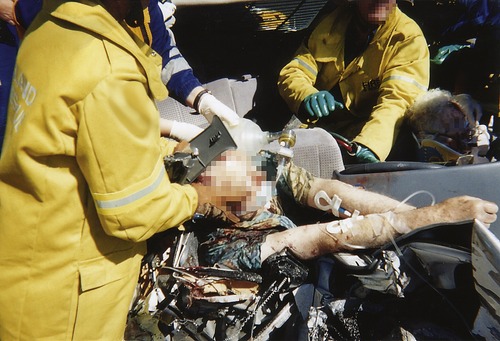CASE 14
 |
Incident
Multiple vehicles have collided at high speed. The tasking agency reports one patient is dead on scene. Two patients are said to be trapped.
Relevant information
▪ Aircraft: Rotary wing. Dual stretcher capacity. Paramedic staffed air ambulance aircraft (single stretcher capacity) on scene
▪ Ground resources: Two land ambulances. Fire & Rescue and Police Services
▪ Retrieval options: General hospital 25 minutes by air. Major trauma hospital 1 hour and 15 minutes by air
▪ Other: Ambient conditions: Dry, 38°C (100°F)
Questions
14.1 Using the information available so far, outline your pre-hospital plan prior to arrival on the scene.
On arrival, you receive a handover from the on-scene flight paramedic. Two vehicles have collided head-on at high speed 35 minutes ago. The driver of one vehicle is deceased. The second vehicle contains two elderly occupants. The driver is trapped and, although he initially responded to voice, he has became unresponsive with increasing respiratory distress. He was intubated (without drug assistance) just prior to your arrival following near respiratory arrest. A weak pulse has been palpable at the wrist. Needle decompression has been attempted on the patient’s left side. The front seat passenger is alert, complaining of neck pain and unable to move her hands or lower limbs despite no physical entrapment.
14.2 Comment on the picture of the scene (page 58) and list, in broad terms, possible life-threatening traumatic thoracic injuries manageable in the field.
14.3 Outline your immediate approach to the scene.
14.4 Describe the assessment of blunt chest trauma in the pre-hospital and transport environment.
14.5 Outline three relevant pre-hospital chest trauma interventions. For each, outline advantages and disadvantages.
Discussion
14.1 Your pre-hospital plan should include issues relating to team and scene safety, utilisation of on-scene resources (including an additional rotary-wing aircraft with experienced crew) and the required transport time to hospital, particularly for the nearest major trauma hospital. En route, the PHR team should also reflect on the number of patients and predicted severity of injury of the survivors given the known mechanism and reported death on scene. Time en route should, therefore, be spent discussing a safe scene approach, preparing for the management of likely severe injuries (including the drawing up and labelling of appropriate drugs) and potential patient triage decisions.
14.2 The image shows only the cabin space of one vehicle with two elderly patients still in the vehicle. There is marked cabin intrusion about the driver’s side, consistent with physical entrapment and suggestive of major truncal injury. Fire & Rescue Service personnel are in attendance. The vehicle has been partially dismantled including incomplete roof removal. It is not clear if the vehicle is stable. A deployed airbag is not visible. There are multiple, sharp and exposed metal surfaces. Blood is evident about the driver who has a tracheal tube and bilateral intravenous cannulae secured in place. Assisted ventilation is being performed. The front seat passenger has had a cervical collar and mask oxygen applied.
Relevant and manageable thoracic threats to life include pleural collections (simple, tension, open or large forms of haemopneumothorax) and large flail segments. Uncontrollable pleural haemorrhage or cardiac tamponade from cardiac or major vessel disruption requires aggressive intervention. This is rarely deliverable in the pre-hospital environment. Unlike penetrating disease (see Case 15), outcomes from resuscitative thoracotomy following blunt trauma are universally poor.
14.3 Immediately seek out the senior Fire & Rescue Service officer and confirm that the scene is safe, the vehicle is stable and there are no undeployed airbags that require restraint. From the received handover, it is clear that the driver requires immediate intervention. However, given the additional patients, the PHR team should consider splitting up in order to further assess the scene (see Case 19).
Rapidly assess the driver’s tracheal tube position (clinically and with an ETCO2 detection device) and ensure adequate ventilation is occurring with high-flow oxygen. Assess for any signs of spontaneous respiratory effort and confirm that a peripheral pulse is palpable. Look swiftly but carefully at the nature of the patient’s entrapment and liaise with on-scene emergency service personnel regarding the current plan. Inform them that the patient requires rapid removal from the vehicle for him to have any chance of survival (‘crash’ extrication – see Case 4). Where possible, extricate the patient immediately to a safe area of the scene and continue simultaneous assessment and resuscitation. Note that, on release, clinical deterioration is likely. This is not necessarily caused by the release of toxic metabolites from ischaemic compartments (as often suggested) but, more frequently, by the loss of tissue, bony fracture and vascular compartment external resistance. If delay in rapid extrication is anticipated and a state of near or actual cardiac arrest is confirmed, commence intravenous fluid or blood resuscitation, attach continuous ECG monitoring for rhythm analysis and perform bilateral chest decompression (see below). Pleural collections under tension must be excluded.
< div class='tao-gold-member'>
Only gold members can continue reading. Log In or Register to continue
Stay updated, free articles. Join our Telegram channel

Full access? Get Clinical Tree








